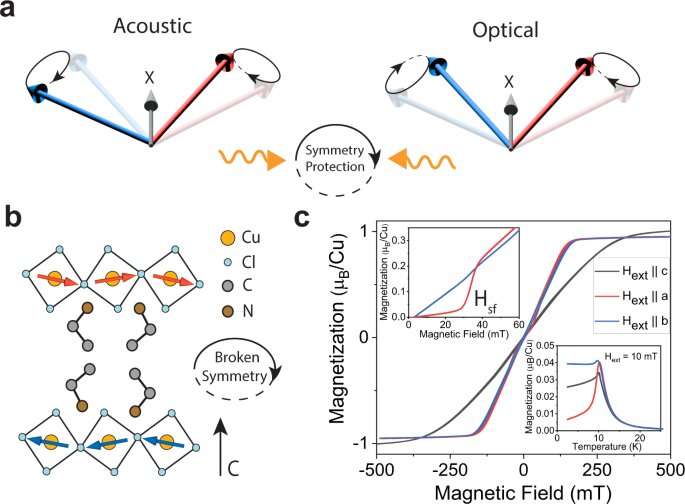This article has been reviewed according to Science X's editorial process and policies. Editors have highlighted the following attributes while ensuring the content's credibility:
fact-checked
peer-reviewed publication
trusted source
proofread
Dzyaloshinskii–Moriya-Interaction allows magnon-magnon coupling in hybrid perovskites

An international group of researchers has created a mixed magnon state in an organic hybrid perovskite material by utilizing the Dzyaloshinskii–Moriya-Interaction (DMI). The resulting material has potential for processing and storing quantum computing information. The work also expands the number of potential materials that can be used to create hybrid magnonic systems. The work appears in Nature Communications.
In magnetic materials, quasi-particles called magnons direct the electron spin within the material. There are two types of magnons—optical and acoustic—which refer to the direction of their spin.
"Both optical and acoustic magnons propagate spin waves in antiferromagnets," says Dali Sun, associate professor of physics and member of the Organic and Carbon Electronics Lab (ORaCEL) at North Carolina State University. "But in order to use spin waves to process quantum information, you need a mixed spin wave state."
"Normally two magnon modes cannot generate a mixed spin state due to their different symmetries," Sun says. "But by harnessing the DMI we discovered a hybrid perovskite with a mixed magnon state." Sun is also a corresponding author of the research.
The researchers accomplished this by adding an organic cation to the material, which created a particular interaction called the DMI. In short, the DMI breaks the symmetry of the material, allowing the spins to mix.
The team utilized a copper based magnetic hybrid organic-inorganic perovskite, which has a unique octahedral structure. These octahedrons can tilt and deform in different ways. Adding an organic cation to the material breaks the symmetry, creating angles within the material that allow the different magnon modes to couple and the spins to mix.
"Beyond the quantum implications, this is the first time we've observed broken symmetry in a hybrid organic-inorganic perovskite," says Andrew Comstock, NC State graduate research assistant and first author of the research.
"We found that the DMI allows magnon coupling in copper-based hybrid perovskite materials with the correct symmetry requirements," Comstock says. "Adding different cations creates different effects. This work really opens up ways to create magnon coupling from a lot of different materials—and studying the dynamic effects of this material can teach us new physics as well."
Chung-Tao Chou of the Massachusetts Institute of Technology is co-first author of the work. Luqiao Liu of MIT, and Matthew Beard and Haipeng Lu of the National Renewable Energy Laboratory are co-corresponding authors of the research.
More information: Andrew H. Comstock et al, Hybrid magnonics in hybrid perovskite antiferromagnets, Nature Communications (2023). DOI: 10.1038/s41467-023-37505-w
Journal information: Nature Communications
Provided by North Carolina State University




















